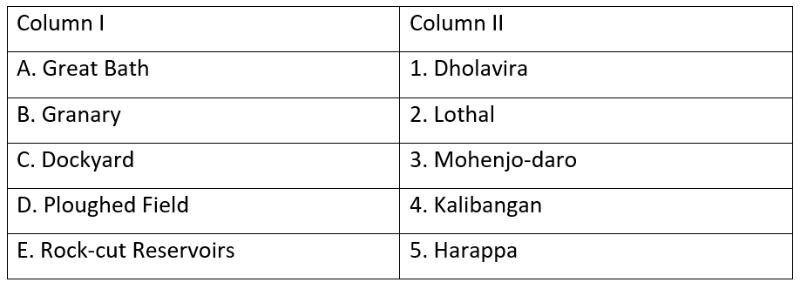ICSE 6 History
The Indus Valley Civilisation


Question 1.
Fill in the blanks [Level: Easy]
(i) The city of ________ was discovered in 1921 by Dayaram Sahni.
(ii) The Indus people used uniformly baked ________ bricks in a 1 : 2 : 4 ratio.
(iii) The public water tank at Mohenjo-daro is called the ________.
(iv) The Harappans cultivated ________, making them the world’s first cotton growers.
(v) The undeciphered writing found on seals is called the ________ script.
Question 2.
State True or False [Level: Easy]
(i) Iron tools are common at Harappan sites.
(ii) Lothal possessed a brick-lined dockyard connected to the sea.
(iii) The citadel was the lower residential area of a city.
(iv) The Great Granary at Harappa stood close to the Ravi River for easy transport of grain.
(v) Harappan inscriptions usually contain long paragraphs of text.
Question 3.
Write the reason for following. [Level: Moderate]
(i) Why are the corners of main streets in Mohenjo-daro gently curved?
(ii) Explain why standardized weights (e.g., the 13.6 g cube) indicate central control.
Question 4.
Short-answer type [Level: Moderate]
(i) Name any two animals depicted on Harappan seals.
(ii) Mention two features that prove Harappans cared for hygiene.
(iii) State two probable uses of the Great Bath.
Question 5.
Match the Columns [Level: Moderate]

Question 6.
Assertion–Reason [Level: Difficult]
Assertion (A): Harappan houses had private wells.
Reason (R): The Indus climate had extremely heavy rainfall throughout the year.
A. Both A and R are true, and R is the correct explanation.
B. Both A and R are true, but R is not the correct explanation.
C. A is true, R is false.
D. A is false, R is true.
Question 7.
Case-based Question [Level: Difficult]
A dig at a new mound reveal:
(a) streets meeting at right angles,
(b) houses with central courtyards and bathrooms,
(c) a seal showing a seated, horned figure surrounded by animals, and
1. Which ancient civilization is the mound most likely part of?
2. What name do scholars give to the horned deity on the seal?
Question 8.
How would the presence of flood-silt layers inside Mohenjo-daro’s houses affect historians’ understanding of its decline? [Level: Moderate]
Question 9.
If archaeologists finally decipher the Indus script and it reveals detailed civic laws, how would that reshape our view of Harappan governance? [Level: Difficult]
Question 10.
Describe in detail the urban planning features of a mature Harappan city and explain how each feature illustrates the inhabitants’ advanced engineering skills and civic sense. [Level: Difficult]
**********
In summary, problem-solving after learning a theoretical concept on CBSE The Indus Valley Civilisation ICSE 6 History is an essential part of the learning process. It enhances your understanding, critical thinking abilities, and retention of knowledge. Moreover, it equips you with valuable skills that are applicable in academic, personal, and professional contexts.
You must have heard of the phrase “Practice makes a man perfect”. Well, not just a man, practice indeed enhances perfection of every individual.
Practicing questions plays a pivotal role in achieving excellence in exams. Just as the adage goes, "Practice makes perfect," dedicating time to solve a diverse range of exam-related questions yields manifold benefits. Firstly, practicing questions allows students to familiarize themselves with the exam format and types of problems they might encounter. This familiarity instills confidence, reducing anxiety and improving performance on the actual exam day. Secondly, continuous practice sharpens problem-solving skills and enhances critical thinking, enabling students to approach complex problems with clarity and efficiency. Thirdly, it aids in identifying weak areas, allowing students to focus their efforts on improving specific topics. Moreover, practice aids in memory retention, as active engagement with the material reinforces learning. Regular practice also hones time management skills, ensuring that students can allocate appropriate time to each question during the exam. Overall, practicing questions not only boosts exam performance but also instills a deeper understanding of the subject matter, fostering a holistic and effective learning experience.
All About Daily Practice Problems on ICSE 6 History The Indus Valley Civilisation NCERT Chapter 3
Our Daily Practice Problems (DPPs) offer a diverse range of question types, including Multiple Choice Questions (MCQs) as well as short and long answer types. These questions are categorized into Easy, Moderate, and Difficult levels, allowing students to gradually progress and challenge themselves accordingly. Additionally, comprehensive solutions are provided for each question, available for download in PDF format - Download pdf solutions as well as Download pdf Questions. This approach fosters a holistic learning experience, catering to different learning styles, promoting self-assessment, and improving problem-solving skills. With our well-structured DPPs, students can excel in exams while gaining a deeper understanding of the subject matter. Hope you found the content on ICSE 6 History The Indus Valley Civilisation NCERT Chapter 3 useful.
Last but not least, to get the best hold on ICSE 6 History The Indus Valley Civilisation NCERT Chapter 3, do not forget to check out: